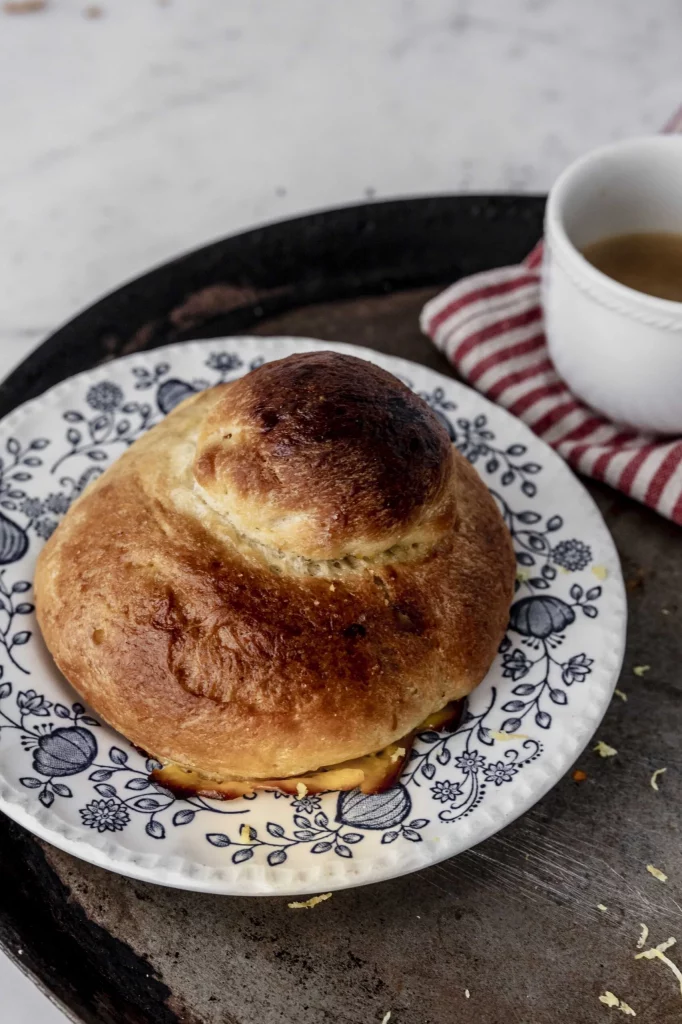In Palermo, and all-around Sicily, brioche is usually paired with granita (or ice-ream): it is a genuine must. Baking brioche is easy, making a good one less, but it is not an impossible challenge. This is tuppo recipe to truly believe in: let me in and prepare these Italian delicacies together.
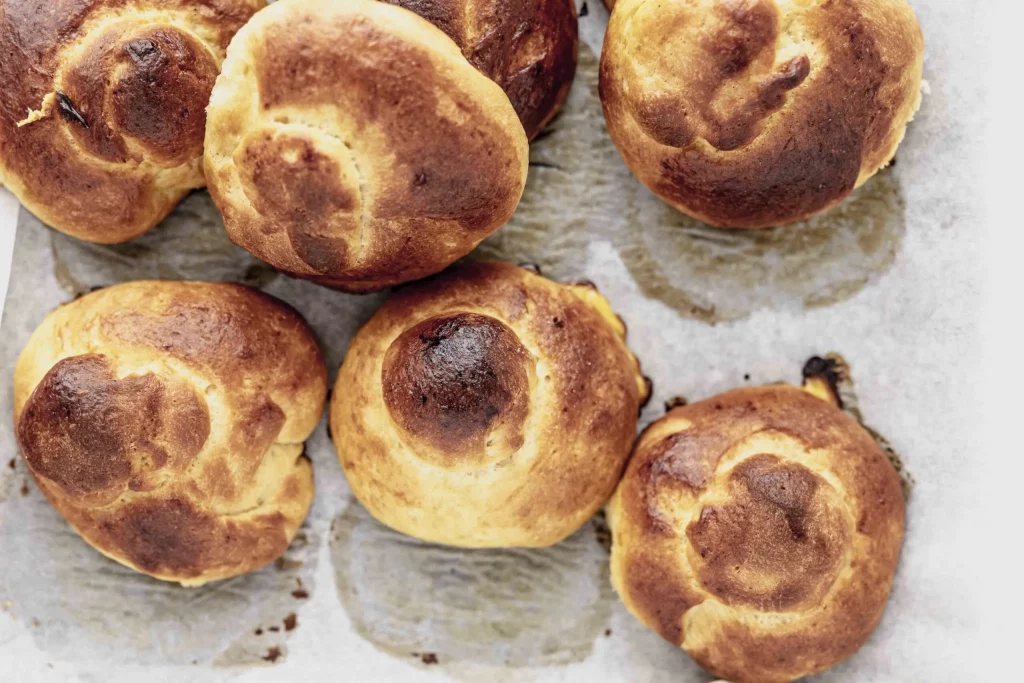
Brioches with tuppo is wonderfully fluffy and soft; round-shaped it is topped by a kind of small ball- the so called tuppo, is on the top if it. When you remove the tuppo, you can appreciate the soft inside, almost stringy, uniquely vanilla scented. Tuppo is the most desirable part of the brioches, it fits to be wonderfully dunked into a creamy granita (almond one perfectly fits) or a great cappuccino. This brioche makes a toothsome breakfast or an afternoon snack (well, have it when you want): enjoy this delicacy by the sea, remember you are in Sicily! You can encounter brioche with tuppo everywhere on the island, from typical Italian “bars” and pastry-shops to street stalls. Their tempting smell spreads all along the streets in big cities or in small villages. You can resist it!
Where does its name come from?
This unique and antique delicacy is named after the low chignon (bun), the traditional way Sicilian women used to comb their hair (that’s how I have combed my hair myself to get into “the role” better): in Sicilian dialect is called exactly “tuppo”.
As you can imagine, you may encounter a thousand local variations of the genuine recipe. Anyway, there are two main kinds of brioches with tuppo: in the first one fewer eggs are used, hence it is white; the second is yellow because of a higher quantity of fats. Are they both scrumptious? Yes, definitely!
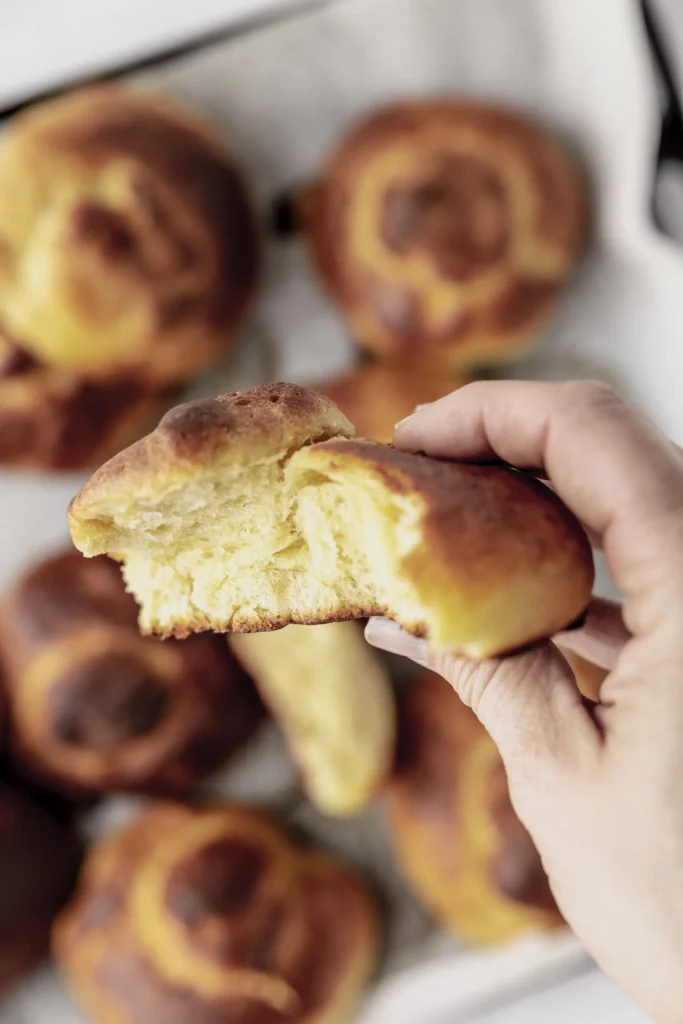
Why is brioche with tuppo so special?
- A unique scent: you must try it!
- Its vivid yellow color: choose the right eggs-those whose yolk is bright yellow;
- Its special texture: it should be as soft as cotton in order to “host” granita or ice-cream as a kind of shell;
- Its superficial crust, which is not a real crust but a sort of soft “film”;
- It is not very sweet because it must be paired with granita which is made of sugar and water.
Tuppo is not an easy recipe: it takes time and patience
The first time I made this recipe, the result was a big heavy loaf rather than some soft brioches. It was good, the granita I had prepared was good too, it was not what I had expected.
I thought about it for a long time, then I understood that flour strength does make the difference, the quantity of liquid it can absorb. This is completely unpredictable, so although the quantities are well-defined (I used the grams because this recipe is very delicate, cups and tbsp are not precise enough). It can vary and flour can be added before the rising process.
Don’t worry…
Because of its long preparation and rising time, brioche with tuppo is considered a complicated recipe even by the most skilled professionals, but a few tricks and some special care will and let you bake incredibly perfumed, fluffy, cotton-like brioches in your own kitchen.
If I managed to, you will too. Don’t worry, all your efforts are worth it! But allow yourself plenty of time.
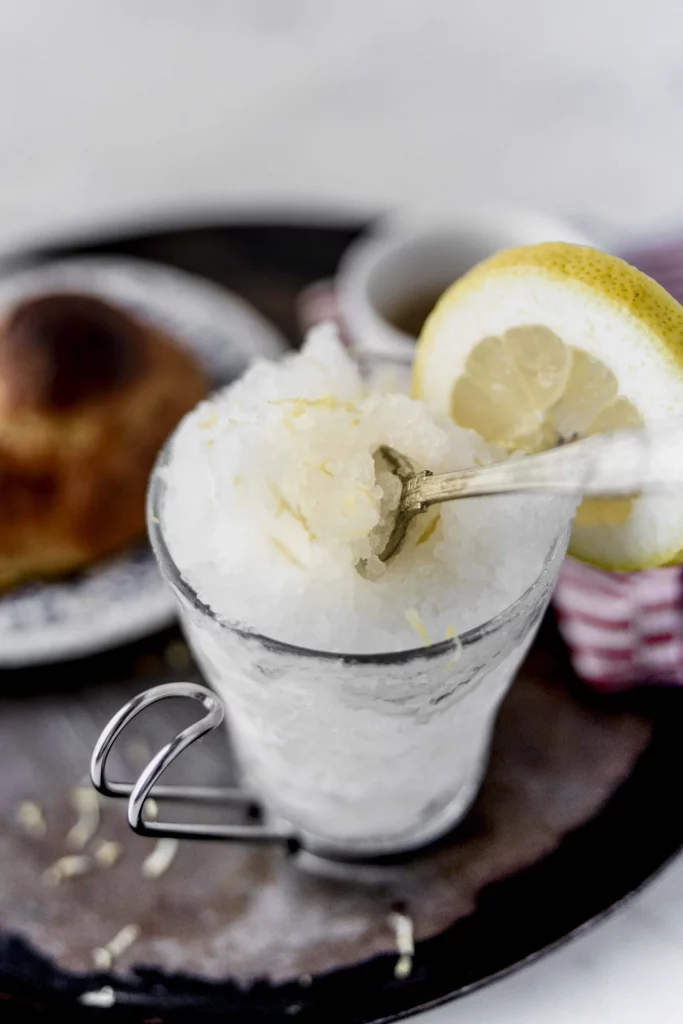
Before getting started:
- Bring all the ingredients to room temperature;
- Start making brioches in the afternoon, so the dough will have enough time to rise in the fridge overnight; the following day it will be ready to be kneaded (don’t get frustrated: the time is long but it is mainly rising time, it is not active time!);
- A food processor or electric mixer is needed; you can knead it with your hands if you are very expert and skilled. A food processor is the easiest solution.
The right ingredients:
- Strong flour: Manitoba flour fits this recipe; you may also use flour type 0. The absorption of water depends on the type of flour, so if you decide to use another kind of flour, you will have to modify the quantity of liquids in the recipe. The final result won’t be the same as the genuine recipe. The only solution is trying to find the right combination.
- Butter: in the past brioches with tuppo used to be baked with lard, today it has been replaced by butter which imparts a sweeter and more delicate taste;
- Vanilla: vanilla flavoring is good, but vanilla pod is much better;
- Eggs: extra fresh and organic; the more yellow the better- you should get those which are used to make pasta. Your brioches will be bright golden:
- Yeast: fresh yeast does make the difference. You may use the dry one in a ratio of 1g to 3g.
- Honey: the delicate and not too persistent taste of multifloral honey fits this recipe;
- Lemon or orange zest makes these delicacies even more flavorful;
- Marsala, or any fortified wine: it imparts more perfume. Some recipes want it in a very small quantity, about 20g per 500g of flour.
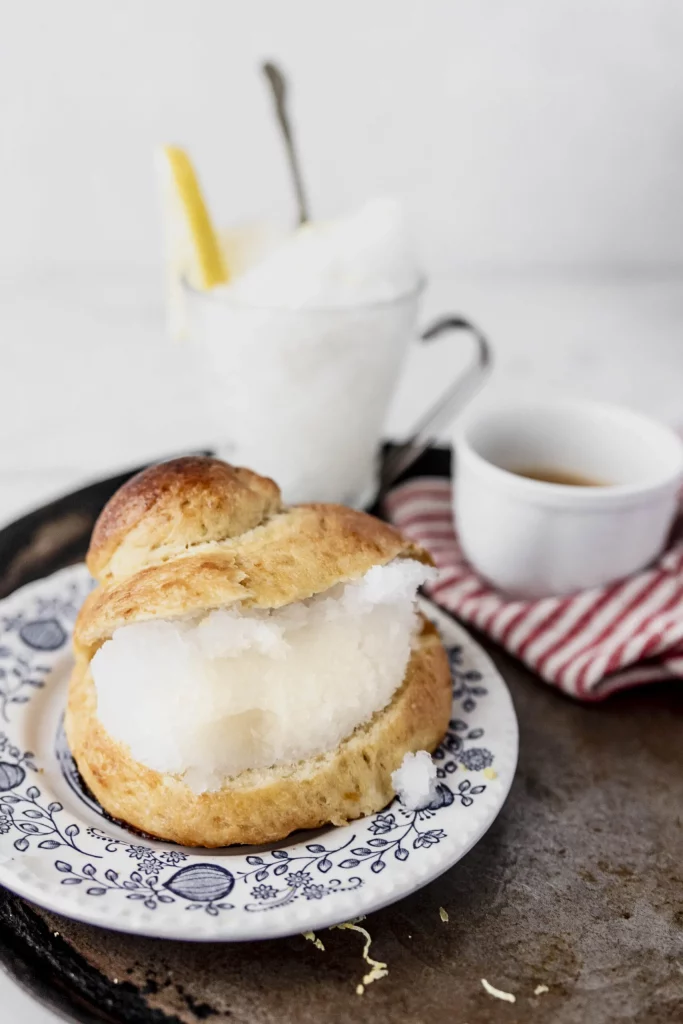
A few tricky points
This is not an easy recipe but it is not impossible, definitely. The final texture of the dough is the main problem, that’s why an electric mixer may be your trump card. It should release from the side of the bowl easily, otherwise you won’t be able to knead and shape it properly before the baking process. Making one big brioche instead of a number of smaller ones can be a likely risk.
In case of sticky dough, add some more flour and knead carefully before making it rise in the fridge. Add little flour, knead the dough until it has been completely incorporated. Of course, if you add too much flour, your brioches won’t be fluffy and airy at all!
Sicilian brioches col tuppo, a recipe to believe in
Ingredients
- 500 gr strong 400W flour or 400g of Manitoba + 100 of flour type 00
- 100 gr fresh whole milk
- 120-130 gr sugar
- 150 gr lard or butter (take it out of the fridge at least 2 or 3 hours before using it)
- 2 XL eggs and 1 small egg
- 15 gr fresh yeast or 5g of dry yeast
- 1 tbs fine salt
- 1/2 vanilla pod or 14g of vanilla powder
- 20 gr marsala or rum
- 1 tbsp acacia or multifloral honey
- 1 egg yolk and some sugar (with a little milk) to garnish
- Half orange or lemon zest
Instructions
- In a bowl, combine the finely grated lemon or orange zest to taste with the liquor to your choice. Cover with cling film and set aside to marinate for at least 30 minutes. If you don’t, like lemon zest, skip the passage and use 120g of milk (instead of 100g); start from the next passage;
- Carefully dissolve the yeast (either fresh or dry) in lukewarm milk to activate it;
- Sift the flour in the bowl of the electric mixer fitted with the dough hook attachment and add the sugar;
- Switch on at low speed;
- With the machine running, pour the milk and yeast mixture;
- Then add one egg at a time; let the egg be completely incorporated before adding another one; don’t turn off the machine but leave it at low speed;
- The mixture is uneven and granular …don’t worry: go on kneading.
- When the dough gets smooth and even, add the softened butter or the lard to your choice. You’d better cut the butter into small dices, or add the lard with a spoon, it will combine with the other ingredients better;
- Knead on medium-low speed for about 5-6 minutes;
- If the dough results too sticky add 2 tbsp of flour, before pouring the mixture with the zest;
- Now take the liqueur zest which has sat long enough: sieve it and discard the zest. You don’t want any traces of zest in your brioches. Pour the liqueur into the dough. Knead until well combined;
- Scrape the seeds from the vanilla pod with a sharp knife and add them to the dough;
- Finally, add the salt;
- Knead at medium speed for at least 15 minutes;
- Knead until a yellow, elastic, bright, smooth, fluffy dough which easily releases from the sides of the bowl. If it sticks to the sides of the bowl, some more flour is needed. If it is too hard, add little more milk. Let the electric mixer run until the right texture;
- Now, the time for the slow rising process in the fridge has come; you can leave the dough into the electric mixer bowl. I usually transfer it to a clean and dry one;
- Turn the dough onto a working (preferably marble) surface, knead fast and shape it into a ball without adding any flour;
- Place the dough into a glass or ceramics bowl; cover it with a tea-towel or cling film. Place the bowl into the middle shelf as farther as possible from the back side which is too cold; let rise overnight (or for about 10 hours);
- The following morning, take the dough out of the fridge and set aside at room temperature for about 20 minutes, or until it is still quite cold, soft, greasy and easy to knead-it should not stick to the working surface;
- Divide the dough into 10-12 balls; cut a very small ball from each piece and shape the tuppo according to the following weights: the base should be about 70-75g, the tuppo 15-20g;
- Smooth the big balls one at a time: they should not be sticky;
- Arrange the balls well-spaced apart (about 7-8cm) onto a baking tray lined with parchment paper;
- Make a small hole with your fingers in order to create a “deep crater” to host the tuppo. This is not an easy operation because the tuppo may fall down along a side, or sinking into the bigger base;
- Make the tuppo like that: take the small ball between the left index finger and the thumb and press it until it “leaks” from your fingers; pull the exceeding edges downward in order to shape two cones; insert the tuppo into the “crater” you will have widen to fit the cone perfectly; so you are sure it won’t move;
- Repeat this operation until you have made all the brioches: cover them with cling film and let sit in a dry place protected from air-streams at about 26°-28°C (79°-82°F9; the switched off oven with the light on is the best solution. After two hours they will have doubled their volume;
- Preheat the static oven at 180°-200°C (355°-390°F); in the meanwhile, beat an egg yolk with a little sugar and a splash of milk;
- Brush the brioches with the egg mixture;
- Bake for about 15-20 minutes or until they get golden brown; switch off the oven and allow to sit for a few minutes for a perfect golden color;
- Remove from the oven and let them cool down on a cooling rack. Enjoy the wonderful perfume which will spread in your kitchen!
How can you keep brioches with tuppo?
They keep fresh up to 1-2 days in plastic food bag (put the brioches into the bags when they are cold). They can be frozen after cooking.

